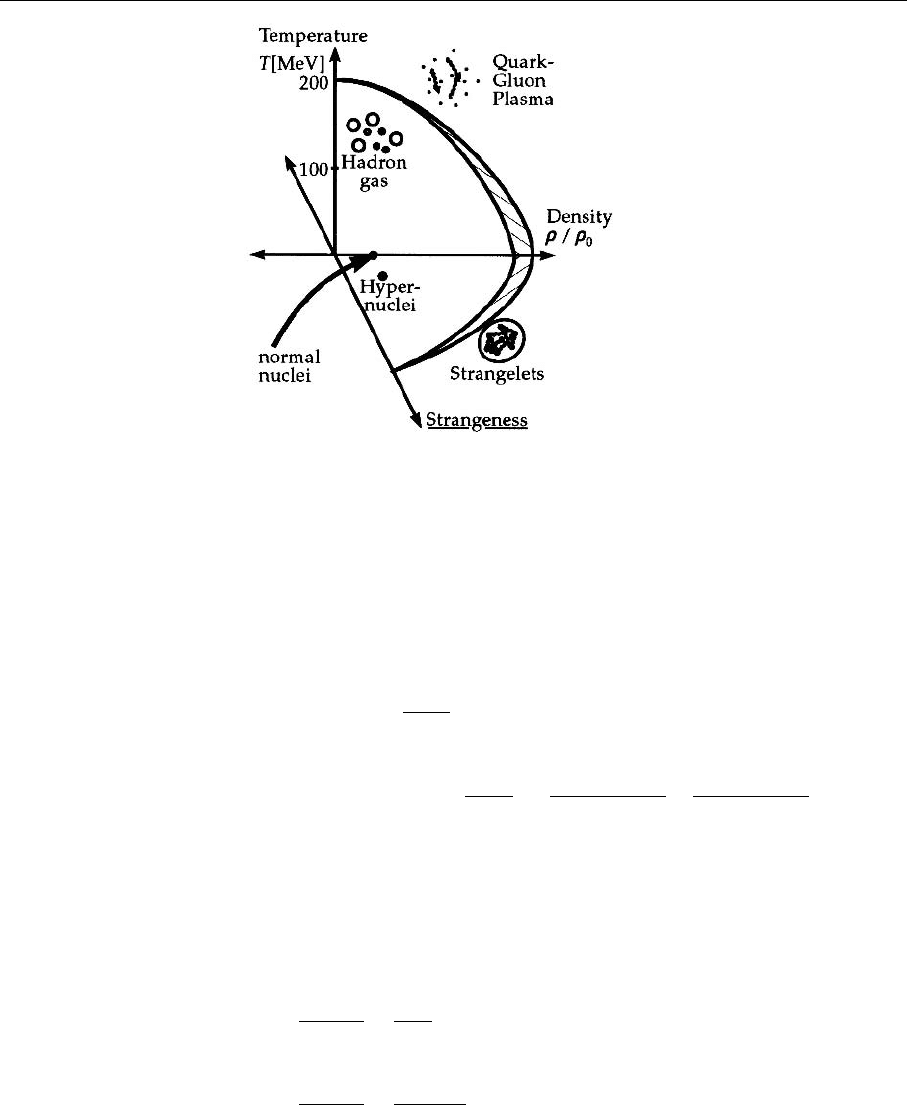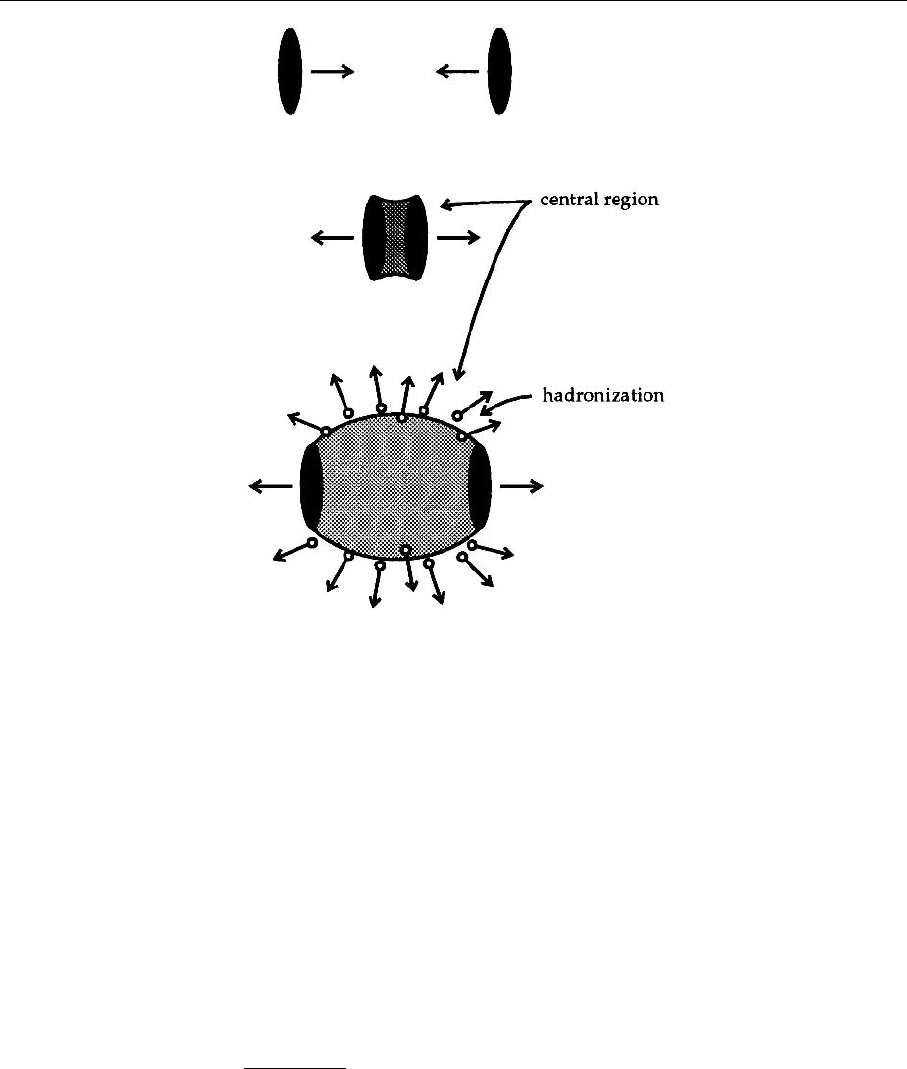Greiner W., Schrammm S., Stein E. Quantum Chromodynamics
Подождите немного. Документ загружается.


8.2 The Quark–Gluon Plasma 531
a complex vacuum state postulated by modern field theory with an energy dens-
ity tens of orders of magnitude larger than any observable energy densities is
probably one of the most interesting and least-tested features of modern par-
ticle theory. To understand some of the problems, let us return to the concept of
parton–hadron duality discussed in Example 5.10. We have argued that the de-
scription of hadronic reactions is in principle possible on the quark level as well
as on the hadron level. These two descriptions are just based on a different set
of basis states. Some processes like deep inelastic scattering can be described
very easily on the quark level but are extremely hard to treat on the hadron level
and such processes therefore allow direct tests of QCD. On the other hand, prop-
erties which are easily described in terms of hadrons and their interactions are
usually not a good test of QCD. Let us therefore start our detailed discussion
by reviewing what hadron models can tell us about the high-temperature phase
transition.
As early as in 1965, Hagedorn
3
observed that the experimentally known mass
density of hadron states grows exponentially,
d
dm
∼m
a
e
m/m
0
, m
0
≈ 200 MeV , (8.34)
and that this fact implies a limiting temperature. With p
2
dp = pEdE,the
number of states with energy between E and E + dE can be written as
dn(E) ∼ dE
E
0
dm
d
dm
e
−E/kT
pE , p =
"
E
2
−m
2
, (8.35)
implying for (8.34) that
dn(E) ∼ dE
E
0
m
a
e
m/m
0
e
−E/kT
"
E
2
−m
2
E dm
= dEE
a+3
1
0
z
a
"
1 −z
2
e
Ez/m
0
dz e
−E/kT
, (8.36)
with m = Ez. Substituting z = cos(ϕ) we get
dEE
a+3
e
−E/kT
π/2
0
cos
a
(ϕ) sin
2
(ϕ) e
E cos(ϕ)/m
0
dϕ. (8.37)
3
See Hagedorn: Suppl. Nuov. Cim. 3, 147 (1965).

532 8. Phenomenological Models for Nonperturbative QCD Problems
Fig. 8.5. Additional contri-
butions to vacuum polariza-
tion in a thermal distribution
of particles. Crosses mark
a coupling to a thermal field
Now we assume E/m
0
1. (This is the relevant limit for our discussion.) We
can then approximate
π/2
0
cos
a
(ϕ) sin
2
(ϕ) e
E cos(ϕ)/m
0
dϕ ≈
π
0
cos
a
(ϕ) sin
2
(ϕ) e
E cos(ϕ)/m
0
dϕ
≈
π
0
sin
2
(ϕ) e
E cos(ϕ)/m
0
dϕ =
√
π
2m
0
E
Γ
3
2
I
1
E
m
0
≈
√
π
2m
0
E
√
π
2
e
E/m
0
√
2π E/m
0
=
6
πm
3
0
2E
3
e
E/m
0
. (8.38)
Obviously the total energy density
+
∞
0
E dn(E) diverges for kT > kT
0
= m
0
≈
200 MeV, because the exponential factor exp(E/m
0
−E/kT ) grows with en-
ergy, implying that either no higher temeratures are possible or that some new
physics must become relevant. As in this treatment the finite size of the hadrons
was neglected, one expects the latter to be the case. Thus we have linked
the existence of a phase transition to the fact that the density of states grows
exponentially with energy. This behavior is, however, nearly universal to all com-
posite models of the nucleon. It is found, for example, for the MIT bag model and
is simply due to the fact that more and more angular momentum states become
available with increasing energy. The phase transition temperature is simply de-
termined by the level spacing between hadrons, and one has to conclude that the
observation of a phase transition alone is not a very sensitive test of QCD.
In terms of quarks and gluons the phase transition can be linked to a reduction
of the effective running coupling constant with increasing temperature as shown
in Fig. 8.6. Finite temperature implies that the state in which a process has to
be calculated is not the field theoretical vacuum state, but a state containing
a thermal distribution of particles. This adds the graphs shown in Fig. 8.5 to the
vacuum polarization tensor. It turns out that the resulting effective coupling con-
stant α
eff
becomes small enough for T ∼Λ
QCD
to suggest the insignificance of
nonperturbative effects.
Another interesting fact is that theoretical studies show that one is really
dealing with two phase transitions. The deconfinement phase transition is char-
acterized by the fact that energy density ε and pressure P approach (although not

8.2 The Quark–Gluon Plasma 533
Fig. 8.6. Running coupling
constant in a pure SU(2)
gauge theory at finite tem-
perature (See B. Müller: The
Physics of the Quark–Gluon
Plasma (Springer, Berlin,
Heidelberg 1985), p. 81)
very rapidly) the corresponding Stefan–Boltzmann limits for a free gas of quarks
and gluons above the phase transition (see Fig. 7.10). Simultaneously one ob-
serves the chiral phase transition which describes the fact that chiral symmetry,
which is violated at low temperatures, is conserved for T > T
c
. According to our
discussion in Sect. 7.2 this implies
¯
qq→0(cf.Fig.8.7),whichisinfactob-
served in lattice gauge calculations. The physical reason for the coupling of these
two phase transitions is still disputed. The link between the two effects is the ob-
servation that the condensate can be expanded in terms of the density of “zero
modes” (i.e. modes with zero energy), which in turn depends on the long-range
properties of the interaction and thus on the presence or absence of confinement:
¯
qq=−
π
V
ν(0). (8.39)
Here ν(Λ) is the density of states which have the eigenvalue Λ with respect to
the Dirac operator −iγ
µ
(∂
µ
−igA
µ
). ν(0) is the density of states at Λ = 0. V is
a normalization factor, namely the total space–time volume considered.
Fig. 8.7. Chiral phase transi-
tion
¯
qq→0 and confine-
ment–deconfinement phase
transition occur at the same
temperature in lattice gauge
simulations

534 8. Phenomenological Models for Nonperturbative QCD Problems
Fig. 8.8. The surface char-
acterizing the transition be-
tween normal hadronic mat-
ter and the quark–gluon
plasma as a function of µ, T,
and
¯
ss content
The properties of the QGP phase transition are further modified by the finite
baryon density in a heavy ion collision, characterized by the chemical poten-
tial µ. Thus the phase transition is characterized by a line in the µ–T diagram, or
even a surface in the µ–T –
¯
ss diagram if the further modifications due to a finite
strangeness–antistrangeness content are added; see Fig. 8.8.
Let us briefly discuss how the µ and T dependence of the phase transition can
be understood. The energy density of free quarks and gluons is
ε = 8 ×2×
∞
0
d
3
p
(2π)
3
p
e
p/kT
−1
−1
+3 ×2 ×N
f
×
∞
0
d
3
p
(2π)
3
p
1
e
( p−µ)/kT
+1
+
1
e
( p+µ)/kT
+1
,
p = E , m
q
= 0 . (8.40)
The first term is the gluon contribution with 8 color states and 2 physical spin
states. The second term is the quark and antiquark contribution for 3 color states,
2 spin states, and N
f
massless flavors.
Making use of the integral formula
∞
0
x
ν−1
dx
e
µx
−1
=
Γ(ν)
µ
ν
ξ(ν)
Re µ>0, Re ν>0
,
∞
0
x
ν−1
dx
e
µx
+1
=
1 −2
1−ν
µ
ν
Γ(ν) ξ(ν) , (8.41)

8.2 The Quark–Gluon Plasma 535
the integrals can be performed analytically:
ε =
16 ×4π
(2π)
3
(kT)
4
Γ(4)ξ(4) +
6N
f
(2π)
3
⎡
⎣
∞
−µ
dp 4π(p +µ)
3
1
e
p/kT
+1
+
∞
µ
dp 4π(p −µ)
3
1
e
p/kT
+1
⎤
⎦
=
8
π
2
(kT)
4
6
π
4
90
+
3N
f
π
2
⎧
⎨
⎩
∞
0
dp
( p +µ)
3
+( p −µ)
3
1
e
p/kT
+1
+
0
−µ
dp ( p +µ)
3
1
e
p/kT
+1
−
µ
0
dp ( p −µ)
3
1
e
p/kT
+1
⎫
⎬
⎭
=
8π
2
15
(kT)
4
+
3N
f
π
2
2(1−2
−3
)(kT )
4
6
π
4
90
+2 ·3 (1−2
−1
)
×(kT )
2
µ
2
·1·
π
2
6
−
µ
0
dp ( p −µ)
3
1
e
−p/kT
+1
+
1
e
p/kT
+1
=
8π
2
15
(kT)
4
+
3N
f
π
2
7
8
2π
4
15
(kT)
4
+
π
2
2
µ
2
(kT)
2
−
µ
0
dp ( p −µ)
3
2 + e
p/kT
+ e
−p/kT
2 + e
p/kT
+ e
−p/kT
=
8π
2
15
(kT)
4
+6N
f
7π
2
120
(kT)
4
+
µ
2
4
(kT)
2
−
1
8π
2
µ
4
+
3
2π
2
µ
µ
3
3
−
3
2π
2
µ
2
µ
2
2
+
1
2π
2
µ
3
·µ
=
8π
2
15
(kT)
4
+6N
f
7π
2
120
(kT)
4
+
µ
2
4
(kT)
2
+
1
8π
2
µ
4
. (8.42)
The pressure P = ε/3 can now simply be equated to the bag constant to
obtain an estimate for the phase-transition line:
B =
8π
2
45
(kT)
4
+2N
f
7π
2
120
(kT)
4
+
µ
2
4
(kT)
2
+
1
8π
2
µ
4
. (8.43)
In deriving this estimate, all interaction effects were neglected such that the nu-
merical values obtained from (8.43) cannot be trusted. However, the general
form shown in Fig. 8.8 should be correct.
Having specified the transition region to the QGP, let us now turn to the
most important question, namely whether the new phase can be reached in

536 8. Phenomenological Models for Nonperturbative QCD Problems
Fig. 8.9. Schematic descrip-
tion of an ultra-relativistic
heavy-ion collision
a heavy-ion collision. To this end, heavy-ion collisions were studied in great de-
tail within many different models.
4
After much controversy it is now established
that very high densities and enormous rates of particle production are reached.
The CERN experiments with 200 GeV/A beams have produced a large amount
of data, testing the existing theoretical models and thus allowing a more trust-
worthy extrapolation to higher energies. The most important result of these and
other studies is that the originally often advocated Bjorken picture of the two
nuclei passing through one another with only very little interaction is wrong. In-
stead enormous numbers of particles are produced, absorbing a large fraction of
the original energy. Schematically the correct picture is given in Fig. 8.9.
Because so many particles take part in the interactions, it turns out that
a hydroydnamic description is applicable except at the highest collision ener-
gies. This description was primarily developed by W. Greiner and collaborators
in Frankfurt. In its language, the crucial mechanism leading to the large energy
deposition is the creation of nuclear shock waves, which had been predicted in
a seminal paper by W. Scheid, H. Müller, and W. Greiner.
5
Other effects pre-
4
For a review see, e.g., W. Greiner, H. Stöcker, and A. Gallmann (Eds.): Hot and Dense
Nuclear Matter, NATO-ASI SERIES B–Physics (Plenum Press, 1994).
5
See W. Scheid, H. Müller and W. Greiner: Phys. Lett. 13, 741 (1974).

8.2 The Quark–Gluon Plasma 537
dicted by the same model have also been observed, namely the fact that some
of the projectiles are deflected for suitable impact parameters (sideways flow)
and that a greater than average number of particles are emitted perpendicular to
the reaction plane (squeeze-out).
Based on all these investigations, one can be optimistic that a phase transition
can indeed be reached, for example, in a heavy-ion collision with 200 GeV/Aat
RHIC. The still unsolved problem, however, is whether there is any signal that
survives the subsequent hadronization. Until now, no undisputed signal has been
found. The hope rests therefore on very exotic objects which one cannot imagine
being produced in a normal nuclear surrounding. Probably the most interesting
of these proposed signals are multibaryon states with a very large strangeness
content. B. Witten
6
and E. Farhi and R.L. Jaffe
7
have proposed that droplets of
QGP could be stable or at least metastable if they contain a sufficient number
of s quarks. The question is thus whether the creation of such droplets, which
are termed “strangelets”, could be aided in a QGP. Greiner, Koch and Stöcker
8
have shown that this is indeed possible. Under the assumption that a mixed phase
of QGP and ordinary nuclear matter is created in a sufficiently large region and
lives long enough (10
−22
s), an unmixing of s and s should happen where the
s quarks gather in the QGP while the
s dominate the hadronic phase as kaons.
If this mechanism is effective enough to collect sufficiently many s quarks in
the QGP, it would not decay and could then remain as a (experimentally easily
detected) strangelet. Let us end this chapter by discussing some other rigorous
results of QCD besides those of lattice-gauge calculations.
As sketched in Fig. 8.6, at high temperature the coupling to the thermal
bath of particles reduces the effective coupling constant. For sufficiently large
temperature the resulting theory should therefore again be tractable by perturba-
tion theory. The most advanced formalism along these lines was developed by
Braaten and Pisarski. It is based on earlier work by Kapusta. Let us just sketch
some of the results obtained. By calculating the lowest-order contributions to
the gluon propagator in a thermal background, Kapusta obtained an effective
propagator which can be written in the form
D
L
(ω, k) =
1
ε
L
(ω, k)k
2
, (8.44)
D
T
(ω, k) =
1
ε
T
(ω, k)ω
2
−k
2
, (8.45)
ε
L
= 1 +
g
2
T
2
k
2
1 −
ω
2k
ln
ω +k
ω −k
, (8.46)
ε
T
= 1 −
g
2
T
2
2k
2
1 −
1 −
k
2
ω
2
ω
2k
ln
ω +k
ω −k
, (8.47)
6
See B. Witten: Phys. Rev. D 30, 272 (1984).
7
See E. Farhi and R.L. Jaffe: Phys. Rev. D 30, 2319 (1984).
8
See C. Greiner, P. Koch, and H. Stöcker: Phys. Rev. Lett. 58, 1825 (1987).

538 8. Phenomenological Models for Nonperturbative QCD Problems
with transverse and longitudinal color-dielectric functions. For a static source
(ω → 0) these equations imply
ε
L
→1 +
g
2
T
2
k
2
1 −
ω
2k
2ω
k
→1 +
g
2
T
2
k
2
,
D
L
→
−1
−k
2
−g
2
T
2
, (8.48)
ε
T
→1 −
g
2
T
2
2k
2
1 −
1 −
k
2
ω
2
ω
2
k
2
=1 −
g
2
T
2
2k
2
2 ,
D
T
→
1
−k
2
. (8.49)
Thus only the longitudinal gluon field is screened, with a screening mass gT,and
corresponding Debye length λ
D
=1/gT. The fact that the transverse propagator
is not screened is one of the problems of this approach. This result of lowest-
order calculations implies the existence of relevant higher-order terms, e.g. m
T
∼
g
2
T . Great effort is currently being invested in calculating these terms reliably.
An interesting point is that the poles of D
L
and D
T
are the effective particles
of the thermal state, the “plasmons”. Some of their properties can easily be read
off from (8.44)–(8.47). For the longitudinal case ε
L
= 0 implies
0 = k
2
+g
2
T
2
1 −
ω
2k
ln
ω +k
ω −k
. (8.50)
For the transverse case ε
T
= k
2
/ω
2
leads to
k
2
ω
2
=1 −
g
2
T
2
2k
2
1 −
1 −
k
2
ω
2
ω
2k
ln
ω +k
ω −k
. (8.51)
To test whether this high-energy phase is really deconfined one has to check
the low k limit, i.e., the properties of the plasmon for large distances. For the
longitudinal case one finds
0 = k
2
+g
2
T
2
1 −
ω
2k
2k
ω
+
2k
3
3ω
3
=k
2
+g
2
T
2
−
k
2
3ω
2
⇒ ω
2
≈ω
2
−k
2
=
g
2
T
2
3
(8.52)
m
L
plasmon
=
gT
√
3
(8.53)
and for the transverse case
k
2
ω
2
=1 −
g
2
T
2
2k
2
1 −
1 −
k
2
ω
2
1 +
k
2
3ω
2
=1 −
g
2
T
2
2k
2
2k
2
3ω
2
=1 −
g
2
T
2
3ω
2
(8.54)

8.2 The Quark–Gluon Plasma 539
ω
2
−k
2
=
g
2
T
2
3
m
T
plasmon
=
gT
√
3
. (8.55)
Thus both the longitudinal and the transverse gluons have, for large distances,
the same effective mass gt/
√
3, implying that the color potentials are screened
and confinement is no longer effective. Let us note that for realistically attainable
temperatures T ∼250 MeV, g ∼ 2 one gets
m
plasmon
∼300 MeV . (8.56)
Obviously the simple idea of a free gas of massless gluons is completely ruled
out by high-temperature QCD, too.
Braaten and Pisarski pushed this kind of calculation much further. They dis-
tinguish three scales, namely g
2
T gT T . Momenta of order gT can be
treated by usual perturbative QCD, those of order T require a careful resum-
mation of contributions of arbitrarily high order in perturbation theory. (This
is achieved by deriving effective vertices and propagators.) Momenta of order
g
2
T cannot be treated. Within this approach a large number of properties were
calculated, but the problem with all of this is that it applies only for g 1, im-
plying a temperature which cannot be reached in any realistic experiment. As
stated above g is even larger than 1. The same criticism applies to approaches
in which the QCD field theory is treated as classical field theory. The classical
Yang–Mills equations show chaotic behavior and B. Müller and collaborators
showed that the corresponding leading Lyapunov exponent can actually be re-
lated to the gluon damping rate as obtained by Braaten and Pisarski, implying
that the regime of asymptotically high temperatures seems to be really well un-
derstood. If one were to simply extrapolate the results of these two descriptions
to realistic temperatures, they would imply very short thermalization times and
consequently very good chances for quark–gluon plasma formation in heavy-ion
collisions, but, as discussed above, such extrapolations are very problematic.
Here we have only been able to sketch some relevant ideas and developments
in this very active field. At present it seems very probable that current heavy-
ion experiments at RHIC and future ones at LHC will study hadronic matter
under conditions where it will show exotic properties. Is is, however, still not
clear whether it will be possible to link these experimental observations to basic
properties of QCD in an undisputable manner.

Appendix
In this appendix we summarize some useful formulas needed to perform QCD
calculations.
ATheGroupSU(N )
SU(N ) denotes the group of unitary matrices of order N with determinant
det =+1. Every N ×N matrix U of the group can be represented through the
generators t
A
(A = 1,... ,N
2
−1) as
U(Λ
1
,Λ
2
,... ,Λ
N
2
−1
) = exp(iΛ
A
t
A
), (A.1)
where we have summed over equal indices A. Since the matrix should be unitary,
the generators have to be Hermitian. Since, further, det U = 1, the generators t
A
have to be traceless. The generators obey the algebra
t
A
, t
B
=i f
ABC
t
C
(A.2)
and are normalized as
tr t
A
t
B
=
1
2
δ
AB
. (A.3)
Here the f
ABC
are the antisymmetric structure constants of the group. One can
also define an anticommutator as
t
A
, t
B
=
1
N
δ
AB
+d
ABC
t
C
, (A.4)
with symmetric structure constants d
ABC
. The completeness relation is
t
A
ab
t
A
cd
=
1
2
δ
ad
δ
bc
−
1
2N
δ
ab
δ
cd
(A.5)
and the Fierz identity
t
A
ab
t
A
cd
=
N
2
−1
2N
2
δ
ad
δ
bc
−
1
N
t
A
ad
t
A
bc
. (A.6)
